
Como is a city and comune in Lombardy, Italy. It is the administrative capital of the Province of Como.

The Battle of Magenta was fought on 4 June 1859 during the Second Italian War of Independence, resulting in a French-Sardinian victory under Napoleon III against the Austrians under Marshal Ferencz Gyulai.

The Battle of Solferino on 24 June 1859 resulted in the victory of the allied French army under Napoleon III and the Piedmont-Sardinian army under Victor Emmanuel II against the Austrian army under Emperor Franz Joseph I. It was the last major battle in world history where all the armies were under the personal command of their monarchs. Perhaps 300,000 soldiers fought in the important battle, the largest since the Battle of Leipzig in 1813. There were about 130,000 Austrian troops and a combined total of 140,000 French and allied Piedmontese troops. After the battle, the Austrian emperor refrained from further direct command of the army.
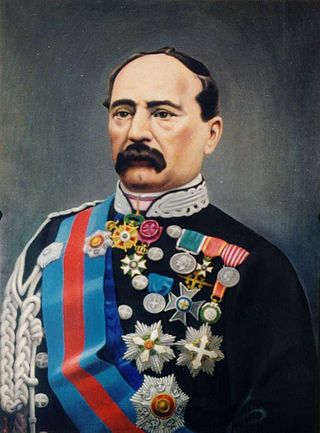
Manfredo Fanti was an Italian general; he is known as the founder of the Royal Italian Army.

The Battle of Caldiero took place on 30 October 1805, pitting the French Armée d'Italie under Marshal André Masséna against an Austrian army under the command of Archduke Charles, Duke of Teschen. The French engaged only some of their forces, around 33,000 men, but Archduke Charles engaged the bulk of his army, 49,000 men, leaving out Paul Davidovich's corps to defend the lower Adige and Franz Seraph of Orsini-Rosenberg's corps to cover the Austrian right against any flanking maneuvers. The fighting took place at Caldiero, 15 kilometres east of Verona, during the War of the Third Coalition, part of the Napoleonic Wars.

The Battle of Sacile on 16 April 1809 and its companion Clash at Pordenone on 15 April saw an Austrian army commanded by Archduke John of Austria defeat a Franco-Italian army led by Eugène de Beauharnais and force it to retreat. Sacile proved to be the most notable victory of John's career. The action took place east of the Livenza River near Sacile in modern-day Italy during the War of the Fifth Coalition, part of the Napoleonic Wars.
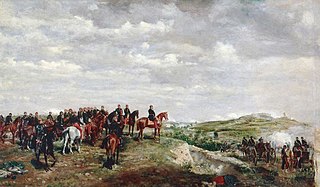
The Second Italian War of Independence, also called the Sardinian War, the Franco-Austrian War, the Austro-Sardinian War or Italian War of 1859, was fought by the Second French Empire and the Savoyard Kingdom of Sardinia against the Austrian Empire in 1859 and played a crucial part in the process of Italian Unification.

The Expedition of the Thousand was an event of the unification of Italy that took place in 1860. A corps of volunteers led by Giuseppe Garibaldi sailed from Quarto near Genoa and landed in Marsala, Sicily, in order to conquer the Kingdom of the Two Sicilies, ruled by the Spanish House of Bourbon-Two Sicilies.
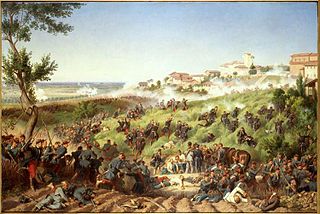
The Battle of Montebello was fought on 20 May 1859 at Montebello. It was the first major engagement of the Second Italian War of Independence, fought between Austrian troops commanded by Field Marshal Karl von Urban against Piedmontese cavalry and French infantry headed by General Elie Foray.

The Battle of Varese was fought on 26 May 1859 at Varese (Lombardy). It was an engagement of the Second Italian War of Independence, fought between the Italian volunteers formation of the Hunters of the Alps, led by Giuseppe Garibaldi, against Austrian troops led by Karl von Urban. The Austrian defeat allowed the movement of the Hunters towards Como, and obliged the Austrians to keep troops on the northern part of the front.

The Battle of Palestro was fought on 30–31 May 1859 between the Austrian Empire and the combined forces of the Kingdom of Sardinia-Piedmont and France. The Franco-Piedmontese forces were victorious. It was fought just south to Palestro, a town in what is now the province of Pavia in northern Italy. It was believed that the Battle of Palestro was the last European battle in which a European Monarch rode into battle, that being King Victor Emmanuel II, who directly entered the fray with the Austrians.

The Battle of Piave River was fought on 8 May 1809 between the Franco-Italian army under the command of Eugène de Beauharnais and an Austrian army led by Archduke John of Austria. The Austrian commander made a stand behind the Piave River but he suffered a defeat at the hands of his numerically superior foes. The combat took place near Nervesa della Battaglia, Italy during the War of the Fifth Coalition, part of the Napoleonic Wars.
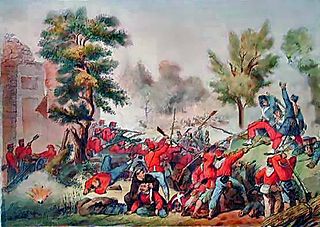
The Battle of the Volturno refers to a series of military clashes between Giuseppe Garibaldi's volunteers and the troops of the Kingdom of Two Sicilies occurring around the River Volturno, between the cities of Capua and Caserta in northern Campania, in September and October 1860. The main battle took place on 1 October 1860 between 30,000 Garibaldines and 25,000 Bourbon troops (Neapolitans).

The Battle of Milazzo was fought on 17–24 July 1860 between Giuseppe Garibaldi's volunteers and the troops of the Kingdom of Two Sicilies at Milazzo, Sicily, then part of the Kingdom of Two Sicilies.
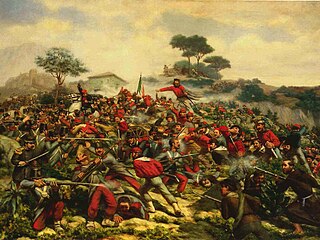
The Battle of Calatafimi was fought on the 15 May 1860 between Giuseppe Garibaldi's Redshirts and the troops of the Kingdom of the Two Sicilies at Calatafimi, Sicily, as part of the Expedition of the Thousand. The battle was the first of Garibaldi's victory during his invasion of Sicily in 1860 and saw his 'Thousand' defeat a larger Neapolitan army sent from Palermo to block the roads to the Sicilian capital.
Count Albert Gyulay de Marosnémethi et Nádaska or Albert Gyulai von Máros-Németh und Nádaska, born 12 September 1766 – died 27 April 1835, a Hungarian, joined the army of Habsburg Austria and fought against Ottoman Turkey. He served against the First French Republic in the Flanders Campaign and on the Rhine. Severely wounded in 1799, he survived a trepanning operation and briefly retired from military service. He returned to active service and commanded an army corps during the War of the Fifth Coalition, part of the Napoleonic Wars. He led his troops in several important battles during the Austrian invasion of Italy in 1809, including one where he was in independent command. Though appointed to command troops in 1813 and 1815, he missed combat in both campaigns. He was Proprietor (Inhaber) of an Austrian infantry regiment from 1810 until his death. The more famous Ignác Gyulay, Ban of Croatia was his older brother.

Karl (Carl) Freiherr von Urban was an Austrian Field Marshal-Lieutenant celebrated for his daring tactics of lightning surprise attacks, often against much stronger forces, which earned him the epithet of Austrian Garibaldi.

The Battle of Turbigo took place the 3 June 1859 saw the French army secure two crossing points over the Ticino River, allowing them to get a foothold in Austrian Lombardy.

The Giuseppe Garibaldi Historical Museum was established in 1932 in Como, northern Italy. It is dedicated to Giuseppe Garibaldi in memory of his activities in the city 1866, and his role in the Unification of Italy.
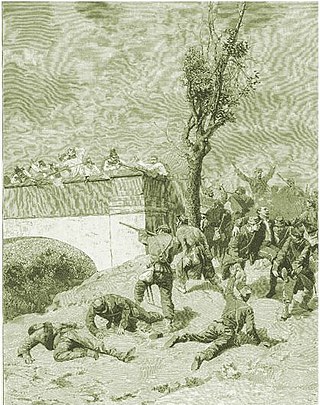
The Battle of Treponti, also known as Battle of Castenedolo, took place on 15 June 1859, during the Second Italian War of Independence. The encounter opposed the Austrians led by Field Marshal Karl von Urban and the Sardinians commanded by Giuseppe Garibaldi. Von Urban employed a cunning stratagem that led to his victory over Garibaldi.



















